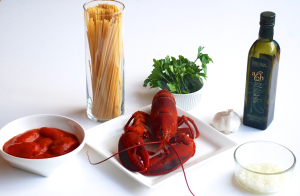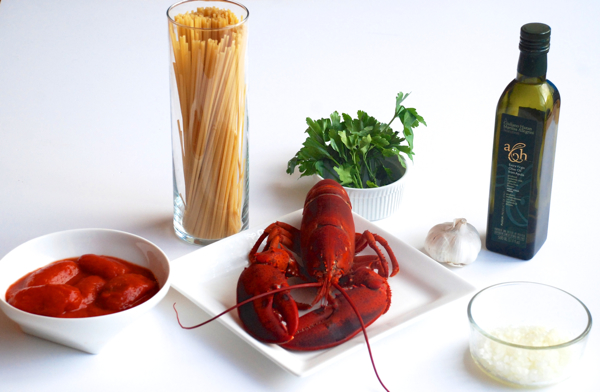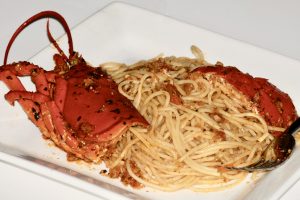 April 15th was Marcella Hazan’s birthday. To celebrate her life and continue her legacy, we are proposing a “group hug” and asking those who wish to be included to make one of Marcella’s recipes. The recipe we’ve chosen is Pasta alla Busara, from Marcella Cucina. It exemplifies Marcella’s unaffected style: wonderfully pure, simple flavors, which are easy to put together and create something magnificently delicious. The dish is from a town in Friuli called Grado, on the northern Adriatic where it is traditionally made with scampi. Since scampi are generally not available in most of the U.S., Marcella’s version uses Maine lobster – but is also excellent with prawns or large shrimp. Alla Busara means something thrown quickly together and that describes this sauce, made of onion, garlic, parsley, and wine to which fresh tomatoes and shellfish are added. If you make it, please share your pictures @ICCedu #CelebrateMarcella. We’d love to see them!
April 15th was Marcella Hazan’s birthday. To celebrate her life and continue her legacy, we are proposing a “group hug” and asking those who wish to be included to make one of Marcella’s recipes. The recipe we’ve chosen is Pasta alla Busara, from Marcella Cucina. It exemplifies Marcella’s unaffected style: wonderfully pure, simple flavors, which are easy to put together and create something magnificently delicious. The dish is from a town in Friuli called Grado, on the northern Adriatic where it is traditionally made with scampi. Since scampi are generally not available in most of the U.S., Marcella’s version uses Maine lobster – but is also excellent with prawns or large shrimp. Alla Busara means something thrown quickly together and that describes this sauce, made of onion, garlic, parsley, and wine to which fresh tomatoes and shellfish are added. If you make it, please share your pictures @ICCedu #CelebrateMarcella. We’d love to see them!
The portion of the Italian coast that, in the northeast, curves over the uppermost tip of the Adriatic Sea, is part of a region known as Friuli-Venezia Giulia. The Venetian Republic ruled here once, and the stamp of Venetian dominion is still clearly discernible in the local dialects and in the structures of the old towns. Both architecturally and gastronomically, the most important of the historic coastal towns is Grado, which, like Venice itself, has based its cuisine on the submarine delicacies of the upper Adriatic.
Of the many superb varieties of seafood native to those waters–the crabs, shrimp, mussels, clams–the most famous is the crustacean called scampi. It is a large prawn with an orange shell whose features–two long pincer claws, a flat tail ending in a fan shape–resemble those of a miniature lobster. Everything can be done with scampi: boiling, frying, stewing, using it in soup, in risotti, in pasta sauces. The tastiest pasta sauce I know made from scampi is the one that originates in Grado and is called, in the dialect of the town, alla busara. “Busara” means something thrown quickly together, and essentially that describes this sauce, a base of onion, garlic, parsley and wine cooked briefly in olive oil, to which the shellfish and tomatoes are added.
Fresh scampi does not swim in American waters, but marvelous lobster does. The flavors are similar, and I found it irresistible to profit from the easy availability of New England lobsters and give them this simple and delicious busara treatment.
INGREDIENTS
Suggested Pasta: First choice is imported, high-quality Italian boxed dry pasta, specifically spaghettini, thin spaghetti. The only homemade noodles that may give you comparable satisfaction are the square ones known as tonnarelli (page 118 of Marcella Cucina)
- 2 one and one-fourth pound live lobsters OR 1 pound jumbo prawns, shelled and deveined and cut in half lengthwise
- One-third cup extra virgin olive oil plus some more for tossing the pasta
- 2 cups finely chopped onion
- Salt
- 3 tablespoons finely chopped garlic
- One-third cup Italian flat-leaf parsley, chopped fine
- One-half cup dry white wine
- 2 cups canned imported Italian plum tomatoes, cut up with their juice OR
- fresh, ripe tomatoes, skinned raw with a vegetable peeler and cut up
- Chopped fresh or dried chili pepper, one-fourth teaspoon or to taste
Killing the Lobsters
The meat will have the sweetest flavor if you kill the lobster yourself just before cooking it. Turn it on its back, holding it down with an oven mitt on your hand, and with the other hand plunge a knife between its eyes and deep into its head. Although the lobster dies immediately, its nervous system may continue to flex the claws for a few more seconds. A less traumatic method–for you, not the lobster–is to drop it into boiling water for 2 minutes. If you don’t feel prepared to deal with a live lobster yourself, you can have the fishmonger kill it, but time it so you can get back to your kitchen and cook the lobster as soon as possible.
Making the Sauce
1. Detach the lobster’s head from the tail. Using poultry shears or a sharp knife, slit the underside of the tail’s shell all along its length, then cut the tail into three pieces. Separate both claws from the head and snap them in two. Crack the claws in several places using a nutcracker or a mallet. Look for and pick out any pieces of shell. Divide the head lengthwise into two pieces. Do not remove any tomalley or roe.
2. Choose a skillet or saute pan that can later contain all the lobster pieces without overlapping. Put in the one-third cup of olive oil, the chopped onion, and a pinch of salt, and turn on the heat to medium.
3. Cook the onion until it becomes colored a pale gold, then add the garlic. Cook a few seconds until the garlic becomes colored a very pale gold and you begin to notice its aroma. Add the parsley, stir once or twice, and then add the wine, letting it simmer for a couple of minutes until the scent of alcohol subsides.
4. Put in the tomato, the chili pepper, and a generous pinch of salt and cook at a steady simmer, until the fat begins to separate from the sauce as described in the Note on page 133, about 15 or 20 minutes.
5. Drop the pasta into a pot of boiling, salted water.
6. Put the lobster pieces (or the prawns) in the skillet with another pinch of salt, turning them over in the sauce for 2 or 3 minutes. If by then the lobster has shed some watery liquid, remove it from the pan using a slotted spoon, and briskly boil away that liquid. Then return the lobster to the pan and cook for another 2 minutes, turning all the pieces over once or twice.
7. Drain the spaghettini when it is still quite firm to the bite, transfer to a very warm serving bowl, pour the contents of the skillet into the bowl, and toss thoroughly. Drizzle in some raw olive oil, toss again until the pasta is well coated, then serve at once.
Ahead-of-Time Note: You can prepare the sauce an hour or so in advance midway through step 6, up to the point where you have removed the lobster from the pan and boiled away any excess liquid. When reheating, bring the tomato to a steady simmer before putting the lobster pieces back in.






One comment
A beautiful and poetic dish! It must taste absolutely fantastic.
Cheers,
Rosa